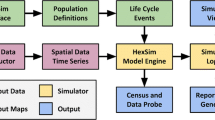Abstract
Simulation models are becoming increasingly important as tools for synthesizing and applying information in almost all aspects of land management. They are particulary valuable for predicting and comparing outcomes of alternative decisions and assumptions. Models also permit managers to consider and integrate the potential influences of a large number of variables.
Similar content being viewed by others
Literature cited
Botkin, D. B., J. F. Janak, and J. R. Wallis. 1972. Some ecological consequences of a computer model of forest growth. J. Ecology 60(3):849–872.
Cattelino, P. J., I. R. Noble, R. O. Slatyer, and S. R. Kessell. 1978. Predicting the multiple pathways of plant succession. Environmental Management 3(1):41–50.
Conway, G. R. 1977. Mathematical models in applied ecology. Nature 269:291–297.
Kessell, S. R. 1978. Phytosociological reference and resource management. Environmental Management 3(1):29–40.
Author information
Authors and Affiliations
Rights and permissions
About this article
Cite this article
Franklin, J.F. Simulation modeling and resource management. Environmental Management 3, 2–5 (1979). https://doi.org/10.1007/BF01867062
Issue Date:
DOI: https://doi.org/10.1007/BF01867062




